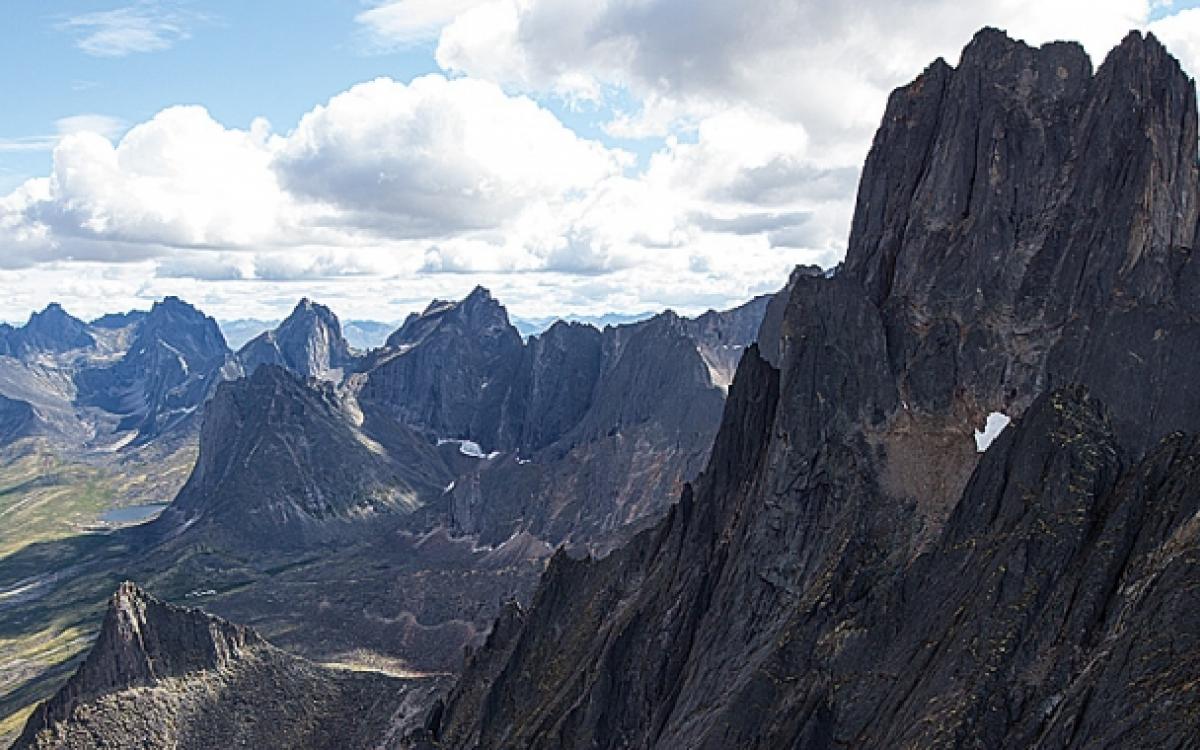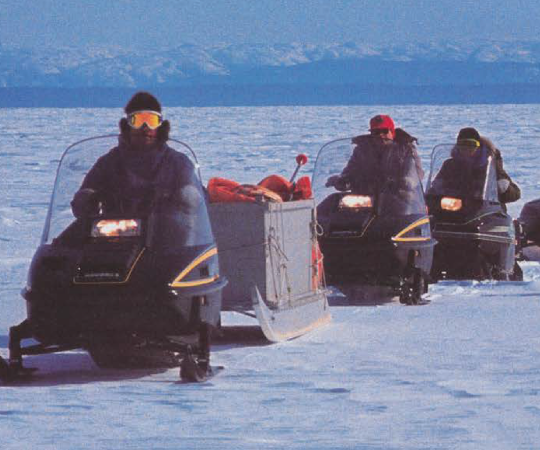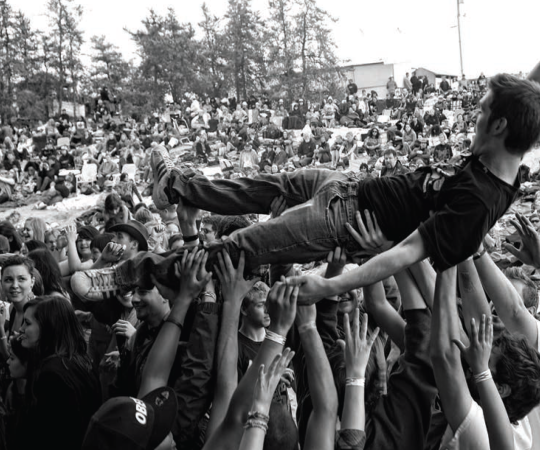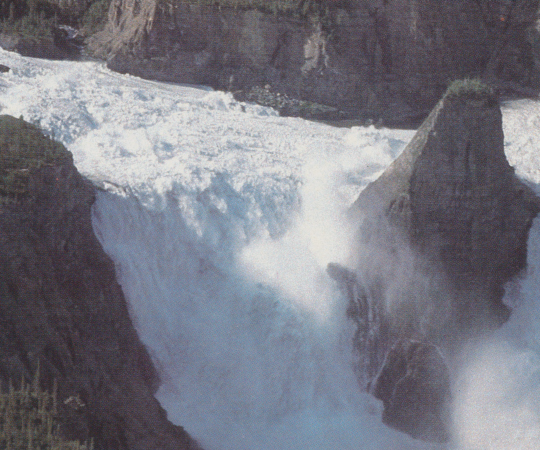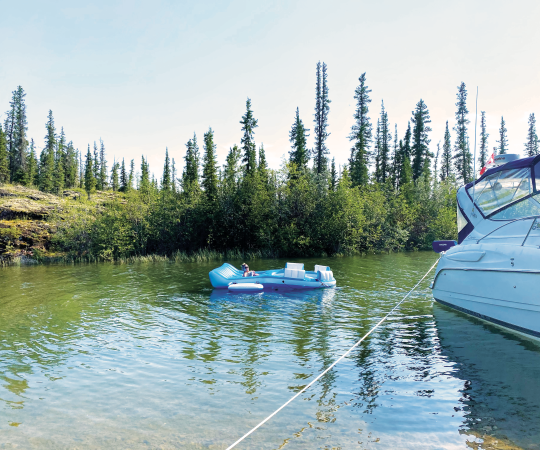The marmots are screaming again. It begins with one adult’s repeated, high-pitched whistle. Then a neighbour joins in, and then another, until the entire colony is shrieking while scrambling for shelter in the jumbled rock piles.
From previous forays into Yukon backcountry I’ve learned this almost certainly signals something big, usually a grizzly, is afoot. I’ve been resting against my pack, taking in the surrounding mountain vista. The craggy peak of Mount Monolith looks pretty grand against the shifting grey sky, its likeness mirrored on the calm waters of the unnamed lakes nestled in the cottongrass meadows of Tombstone Pass.
My partner John, unaware of the situation, is on a ridge to the northwest, scoping a potential route to an alpine lake beyond the ragged peaks so typical of Tombstone.
As the marmot calls intensify, I rise. It’s folly to ignore such signs when hiking deep in Tombstone Territorial Park. They’re now whistling, and it’s definitely not at me, a little blonde lady sitting among the flowers. I turn, slowly, anticipating a towering seven-foot wall of grizzled fur.
But it’s not a bear. It’s a lone white wolf, looking just as startled as I do. It’s both captivating and intriguing. What were his intentions, had the marmots not blown his cover? Was he curious, or just peckish?
This is not my first run-in with wildlife. My love of the outdoors was cultivated early, on the family farm in northern Ontario, where black bear families occasionally occupied our school bus stop. Coyotes, raccoons and moose crossed my path as I picked daisies in the pastures among the cows. These early experiences with nature, coupled with every story and photograph of Northern landscapes I could get my hands on, ignited wilderness daydreams. Restless, I left high school, stepped out onto the highway with a brand new green backpack on my shoulders and pointed my thumb north, to the Yukon.
Because we’ve been travelling the Yukon’s wilderness for so long, we’re possibly more comfortable there than walking down Main Street in Whitehorse. We have gladly traded the security of our future for the surprises of the wilderness.
More than a decade later, I am still entranced by this wild land. For four sweet months each summer, John and I cast off work’s gilded handcuffs to wander the backcountry. We’re often asked if we’re trust-fund babies, but the simple truth is we forego many of life’s pleasures, comforts and conveniences, in exchange for time. We’ve made hiking and paddling—not paying mortgages or chasing job promotions—the priority in our lives.
We know we can’t take this for granted. We’re not immune to rising living costs and job uncertainty. And our health won’t last forever—already, I’m feeling pains I’d rather not think about for now. We’re always asking ourselves whether it’s time to settle down, to hold onto the jobs we so carelessly toss as soon as the weather warms and the snowpack begins to melt.
Because we’ve been travelling the Yukon’s wilderness for so long, we’re possibly more comfortable there than walking down Main Street in Whitehorse. The wilderness is where I feel limitless and content. An upbringing in poverty taught me happiness in simplicity, and we have gladly traded the security of our future for the surprises of the wilderness. So when a gang of marmots gets all rowdy and a wolf sneaks up on me, I don’t long for four sterile walls and a roof. I yearn for a conversation. It’s these interactions and their accompanying sense of coming home that keep us venturing into the wild each summer, for as long as we can make it so.
***

For 10 days, in between hiking Tatshenshini-Alsek Provincial Park and paddling the length of Kusawa Lake, our home was 70 gravel kilometres north of Dawson City along the Dempster Highway, in Tombstone. The park was created 10 years ago—around the time John and I met and began our seasonal backcountry wanderings together—after the signing of the Final Agreement between the Tr’ondek Hwech’in and the Federal government. With mining interests growing nearby, the park protects extensive alpine meadows and jagged mountains, untouched lakes and diverse populations of flora and wildlife. And, of course, the life we lead.
Known as the Patagonia of the North, the jagged mountains of Tombstone rival the sensational views of the famous Torres del Paine. But you won’t find backcountry huts here, nor crowds, nor trails beyond a day’s hike. Hooves and paws, not boots, have created these worn, beaten paths.
There are only a handful of maintained trails in Tombstone. For the experienced backpacker seeking solitude and the challenges of a track-less wilderness, the opportunities are vast. Despite our repeated visits, John and I have only begun to intimately understand the life of this park.
On our first day, we follow a maintained trail leading to the popular Grizzly Lake campground. This and the two other established campsites in Tombstone’s backcountry can get busy in the summer and require permits. Only a few ever venture away from the relative civility of tent pads and outhouses and into the wilderness beyond.
As we travel from the highway, the birdsong gets clearer and the wildlife more plentiful. Around us, critters scurry about their business, surviving and reproducing, our passing little more than an interruption or curiosity.
Wolfing back handfuls of trail mix, we watch a fearless, presumably sodium-deprived, arctic ground squirrel furiously lick clean the sweat from my trekking pole handles. Below us, a female moose stops grazing to stare at the two laughing intruders sitting in the scree.

On the second day, we set up camp in an open alpine valley behind Mount Monolith. The tiny Twin Lakes, snug against the mountain, beckon us for a pre-dinner stroll. After a few hours of roaming, we return to camp to find half our tent footprint pulled out and flapping in the evening breeze. A marmot has not only gnawed on a corner of the footprint; it has also chewed a hole in the tent zipper, entered and taken a giant chomp of my air mattress, before escaping. We don’t get it; there’s no reason for the intrusion. We never store food in the tent.
While I fire up our single burner stove to cook a one-pot dish of rice and beans, John attempts a quick field repair, but can do little to fix the zipper. From here on, we have to stuff toilet paper in the gap to keep out the persistent mozzies. And I’ll have little more than a thin slab of nylon for a mattress. No amount of glue or fabric patches can stop up marmot-tooth gashes.
In one heartbeat that seems to stretch an eon, mother grizzly charges, cubs following without hesitation.
A few days later, after ascending a steep ridge leading up to Sheep Pass, we throw down our packs, slumping down exhausted. John rummages through his pack for lunch, grumbling about someday buying a burro, reminding me that he’d prefer canoeing—a pastime he considers far more gentlemanly and sophisticated. Meanwhile, all I can think about is working out the kinks from my back and neck from sleeping on the cold, hard earth. While scanning for bears, we spot a tawny snowshoe hare bounding across a sandy ridge below us and disappearing into the willows. Immediately behind, something small, dark and swift follows. It’s a pine marten.
A moment later the hare reappears, tearing back across the ridge, the marten in hot pursuit. Back and forth the two creatures, locked in a bitter fight for survival, dart across the sandy ridge and into the cover of willows. After a few close calls the hare finally shakes off its pursuer, tearing down the ridge. The marten reemerges from the brush, hopping from willow bush to scrub birch patch, rising on hind legs, desperately trying to catch a scent of its lost dinner.

there we carry on, climbing around precipitous cliffs and battling tangles of willow and scrub birch. We reach the alpine of Sheep Pass, and there, in the meadow ahead, is a foraging black bear. We quickly turn back into the willows and scramble up scree slopes, giving the bear a wide berth. A couple of young Dall sheep look on. Like the bear, they seem unperturbed.
The rugged landscape and wildlife encounters, by this point, have been exhausting enough for one trip. We start to slow down. But as we descend the other side of Sheep Pass, conspicuous brown lumps appear in an otherwise green meadow. I point: “Hey, doesn’t that look like…” and, as if in a cartoon, up jumps a female grizzly, quickly flanked on both sides by her three, almost adult-sized cubs.
We do what any level-headed, experienced backcountry adventurer does in this case: swear loudly, grab our capsicum bear sprays, and swear some more when our hands shake too hard to prepare to set them off. “Oh shit! And they’re f***ing coming this way!”
In one heartbeat that seems to stretch an eon, mother grizzly charges, cubs following without hesitation. We slowly retreat. I hear John mumble something about not having enough bear spray for this many grizzlies, but who the hell walks around armed for this kind of showdown?
Years ago, to familiarize ourselves with the effectiveness of bear spray, we assaulted an abandoned refrigerator we’d stumbled upon on the outskirts of Whitehorse. But no drill compares to the real thing.
Within 50 metres the female abruptly stops and stands, cubs following her lead. But they’re still close enough for us to confirm, as John now likes to tell people, that mother grizzlies do in fact have six nipples.
For a silent moment, all six of us stand still, waiting for the first move. Then, with a giant headshake from mama grizzly, they turn away, galloping up Sheep Mountain and disappearing over the summit. Turns out, as we’ve read so often in bear behaviour books, this is your classic bluff charge scenario.
As the distance grows, John and I can finally breathe and appreciate the scene before us, watching the runt lag behind, the mother pausing to wait. Even then, the grizzlies climb in minutes what would have taken us an hour.
With hearts still pounding, we descend quickly off Sheep Pass toward the forested Tombstone Valley. We find a grassy hill with open vistas—no bears in sight—to rest and calm our nerves. While photographing blooming arnica and bistort, I spot a massive bull caribou resting on a ridge below. Without any great hurry, the caribou stands up, relieves himself and trots off, disappearing into the willows below. His resting spot is very worn and trampled, obviously a favourite retreat for this big male to survey his domain below.
***

When travelling the backcountry, how we fit into this world is clearly defined, our abilities and weaknesses easily understood. The stress erodes almost instantly when we leave the city. Out here, the random thoughts pulsing through my mind are of mosquito biology, bistort reproduction and northern shrike feeding behaviour. Not unpaid bills, unreturned emails or looming appointments.
The white wolf shows up a few days after the grizzlies. He watches me for a few minutes before trotting away and uphill toward John some half a kilometre away, who’s facing the opposite direction. I’m too far away to call out to John, and I hope he’ll catch the wolf in time to snap a photo.
I watch the wolf walk up behind him just as he did with me, then suddenly dart away, across the hillside and down into another valley.
“Please tell me you got pictures,” I say when John heads back.
“Of what?” He asks, as I grin. “What did you find?”
“It’s what found me. A wolf.”
Even in the Yukon, it’s rare to see a wolf, let alone have a white one approach so closely. Grizzlies seem the epitome of pristine wilderness, yet it’s rare for us to travel the alpine and not see a few grizzlies. Wolves, on the other hand, are much more elusive; we usually only see them from the canoe. I’ve had wolf pups run off with my freshly laundered knickers that I’d left to dry on a branch while I slept. I’ve eaten dinner while listening to wolf song across a lake. But to interact with a wild wolf is a rare and magical moment. I don’t usually perceive wolves as a threat, at least not until one sneaks up behind me.
We don’t live off the land, so we reluctantly return to our car and head back to town. It’s like walking away from a great love.
On our last night, a tent pole shatters—and it’s a brand new tent, just 15 days out of the package. And then, while hiking a well-beaten animal trail through the deepest, thickest willows growing in the North Klondike Valley, we stumble upon a bear stomp. Near a bog stand two battered spruce trees, spaced generously for a large grizzly to lean against and scratch its rump.
Tufts of grizzled fur cling to broken twigs and fresh paw prints in the damp earth mean the bear is still nearby. And with 10-foot willows obscuring views and muffling sounds, it won’t be easy to bushwhack our way out of another grizzly encounter.
It’s looking grim, and part of it has to do with the ever-persistent storm clouds casting dark shadows from above. Despite all that, we don’t want to leave Tombstone and its bright yellow draba, forget-me-nots, violets, metallic blue inky gentians. We’ve seen caribou, bears and wolves; we’ve hiked alongside wandering tattlers, collared picas and families of Dall sheep.
But we’re out of food. We don’t live off the land, so we reluctantly return to our car and head back to town. It’s like walking away from a great love, and the only way we know how to overcome our longing is to immediately begin planning our next trip into another quiet wild valley tucked deep inside the heart of Tombstone. And we know it won’t be long before we return.
Or at least, for a while. I’ve got a growing list of symptoms hinting at an autoimmune illness—fatigue, swollen joints, rashes—and I’m forced to reevaluate those plans for more backpacking. I’m glad I’ve never frittered away a single opportunity. Now I’m weighted down with all the What Ifs—what if I won’t be able to schlep a 30-pound pack across the alpine? What if pain and swelling begins to seize more joints? What if my energy and pep never return? The hope is my illness will remain mild, that I will be able to continue my life with only a small reduction to my activities.
But I also face the very real threat that my illness will attack vital organs or, an unthinkable thought for someone who thrives on being outside, developing severe sensitivity to sunlight.
So far, my impending diagnosis only means that if playing in the woods brings me the most joy, I should pursue this until my body tells me otherwise.
Driving south on the Dempster Highway back to Dawson, John and I struggle to readjust to the unnatural speeds, the scenery blurred and dizzying. And as we reflect on the past 10 days, our hearts sink when we come upon the body of a lynx kitten on the road. We step out of the car and carry it to the side of the highway, its body still warm. Bloody tire tracks trail down the road.
A truck passes spraying rocks, not slowing; how little room we cede to wilderness. As we place the kitten down in blossoming pink fireweed, we can at least find small comfort knowing Tombstone Park protects a patch of Yukon’s northern wilderness, youth, and future hopes.

